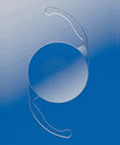Cataracts
Cataract Surgery
 A cataract is a term for the natural lens in your eye when it becomes dense and cloudy. There is no pain associated with the condition but there are other symptoms, including:
A cataract is a term for the natural lens in your eye when it becomes dense and cloudy. There is no pain associated with the condition but there are other symptoms, including:
- Blurred/hazy vision
- Spots in front of the eye(s)
- Sensitivity to glare
- A feeling of “film” over the eye(s)
Cataract surgery is a minimally invasive procedure that involves breaking up the cloudy lens and removing the pieces from the eye. Once the cloudy lens has been removed, a new artificial lens is implanted. This lens is known as an intraocular lens (IOL), and is inserted through the same small incision from which the old lens was removed.
Deciding to undergo an intraocular lens implant is an important undertaking that requires careful consideration of your health, your vision goals and your options. Exploring your options is best handled in the context of a face-to-face consultation with a doctor so that you can learn about the available intraocular lens options in a comfortable, professional and relaxed environment.
There are several different IOLs available to help each patient achieve the best possible results from his/her cataract surgery. Standard distance monofocal lenses help you see objects far away clearly, but you may still have to rely on glasses for reading. Standard reading lenses help you see things at near distance clearly, but you will still have to wear glasses or contacts for distance vision if you needed them prior to surgery. Monovision lenses provide a different IOL for each eye, so one is used for distance vision and the other is used for reading. Your brain will adjust and automatically choose the image from the eye with the correct lens for the task. This may eliminate your need for glasses completely.
Click on the below links to to learn more about cataracts and the technological advancements that you have for surgical options:
Toric IOL
 Toric IOLs are specially designed to correct astigmatism along with overall vision during cataract surgery, offering complete vision correction.
Toric IOLs are specially designed to correct astigmatism along with overall vision during cataract surgery, offering complete vision correction.
Before Toric IOLs, people with astigmatism would need to undergo corneal refractive surgery after their lenses were implanted, or would remain dependent on glasses or contact lenses. The advanced Toric IOLs correct the imbalance caused by an irregular cornea shape in patients with astigmatism. There are several different types of FDA approved Toric IOLs, including AcrySof® Toric Lenses, which can correct up to 4 diopters of astigmatism.
The risks of a Toric IOL include poor vision as a result of the lens rotating out of position, although this risk exists with any type of intraocular lens. Toric IOLs are considered safe for most patients with astigmatism and are the only solution to correct vision problems associated with both cataracts and astigmatism. Talk to your doctor to learn more about these lenses and find out if you can enjoy the benefits of Toric IOLs.
Multifocal IOL: PanOptix/Symfony/ReSTOR®/Tecnis®
 For years, patients who underwent cataract surgery had to wear glasses or contact lenses afterwards to see clearly. The newly developed ReSTOR® lens has overcome this problem, allowing patients to see better than ever before – without the help of corrective eyewear.
For years, patients who underwent cataract surgery had to wear glasses or contact lenses afterwards to see clearly. The newly developed ReSTOR® lens has overcome this problem, allowing patients to see better than ever before – without the help of corrective eyewear.
Philadelphia Ophthalmology Associates is pleased to offer cataract patients the Alcon AcrySof® IQ PanOptix® Trifocal Intraocular Lens (IOL), the first trifocal lens for cataract patients that received FDA approval in September 2019.
The PanOptix® lens has been suggested as a “Next Generation Trifocal lens” because it was designed to provide clear vision at near, intermediate and far distances without the aid of glasses. PanOptix® builds upon Alcon’s AcrySof®IQ intraocular lens technology, that has been implanted in more than 120 million eyes globally.
The PanOptix® lens uses ENLIGHTEN® Optical Technology, a proprietary design that optimizes intermediate vision without compromising near and distance vision. It does so in two ways:
- By maximizing the amount of light that reaches the retina, giving you crisp vision at every distance under various lighting conditions and
- By setting the intermediate vision focal point to a distance that is well suited for today’s lifestyles.
So properly selected PanOptix® patients can, for instance, read menus (near vision), work at their computer (intermediate vision) or play golf (far vision) with relative ease.
The FDA approved TecnisSymfony® IntracularLens (IOL) is the first and only Extended Depth of Focus (EDOF) Presbyopia-Correcting IOL that provides continuous, high-quality vision at any distance–from near to far and points in between –and may reduce frequency of wearing glasses.
Extended Range of Vision IOL is available in both a Non-Toricversion and a Toricversion for patients with astigmatism.
The ReSTOR® lens improves upon ordinary cataract replacement lenses (IOLs) by providing comprehensive focusing capabilities so patients can see clearly in a range of distances. Up to 80% of patients who use the ReSTOR® lens don’t need to rely on glasses or contact lenses after surgery.
Another similar option is the Tecnis® Multifocal IOL, which can be used for those patients with or without presbyopia. The Tecnis® IOL is meant to improve functional vision – the ability to see objects in varying light conditions – especially at night and twilight and in rain, snow and fog. Plus, up to 90 percent of Tecnis® Multifocal IOL patients do not require reading glasses.
Your doctor can help you determine which of these IOL lenses might be right for you.
YAG Capsulotomy
During cataract surgery, your doctor replaces the cloudy lens (cataract) with an artificial one to correct vision. However, after surgery, many people experience a gradual clouding of the membrane behind the lens - a condition known as posterior capsular opacification. This is very common and even though new surgical techniques delay its onset, it will most likely occur at some point after cataract surgery and can cause blurred vision to return. Fortunately, a solution is available.
A procedure called a posterior capsulotomy, using an Nd: YAG laser, can be performed to remove the back lining of the lens capsule and let light pass through to the retina. The laser cuts a hole in the back lining and helps eliminate the cloudiness that is caused by the opaque membrane.
The capsulotomy can be performed in your doctor’s office and is a painless procedure that does not require any anesthesia.
It is important to weigh the possible risks and benefits, similar to that of the original cataract surgery, before deciding upon treatment. Most people experience improved vision and reduced glare after undergoing a posterior capsulotomy.


